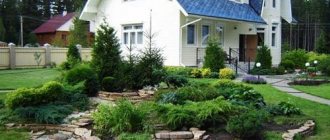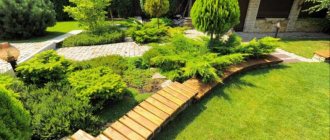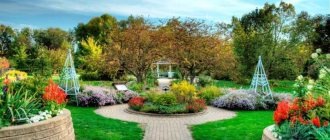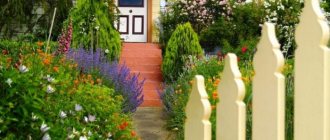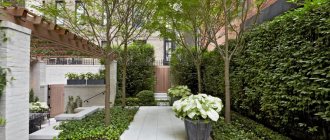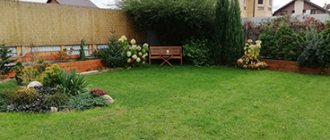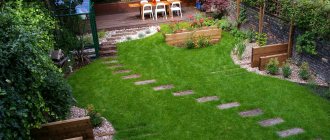Read: 9,137
Modern park culture has made a huge step towards transforming parks and squares from a banal place for walking among green spaces into a place of mass and cultural recreation, where various returning categories of people can spend time without conflicts. Everything is organized in such a way that no one disturbs each other and everyone can find something to their liking, enjoy the excellent landscape design and sophisticated aesthetics of the architectural complex, engage in sports, hobbies, favorite activities, art, or take time for solitude with nature. And to get such a result, you first need high-quality design projects for public gardens . How are they created? What styles are there? What is important to pay attention to? And what are the requirements for modern parks from visitors? We propose to deal with all these issues within the framework of this article.
English style
This style of park design is also called landscape. It promotes man's caring attitude towards natural objects. The main feature of this style is the combination of negligence, the natural arrangement of all the constituent elements with the well-groomed area.
Did you know? The ancient Greeks were involved in landscape design in the 10th century. BC e. In addition to plants, they used statues and columns to decorate the site.
Characteristic features of the English style:
- all lines are smooth and curved, without sharp protrusions;
- the house is an integral element of the overall design of the site;
- the use of climbing plants and vines for vertical gardening;
- paths are paved with stone slabs, cobblestones or bricks;
- benches, flowerpots, statues, gazebos made of stone and wood;
- neat green lawns;
- living corridors formed by plants and shrubs of varying heights;
- the presence of antique objects, forged fences and lanterns, handicrafts;
- bright and contrasting flower beds, made in the form of a carpet or hill;
- a large number of perennials;
- an artificially constructed reservoir or stream with a small bridge;
- an abundance of roses, poppies, hollyhocks, begonias, multi-colored delphinium in lush flower beds.
Fashion trends
Fashion in landscape design, unlike fashion in clothing, is democratic. Although it is also conventionally divided into high and pret-a-porte. High fashion is dictated by the annual exhibition in Chelsea, which has been organized by the Royal Horticultural Society of Great Britain since the end of the 19th century. In recent years, high fashion has been emphasizing the ecology of landscapes, paying more attention not to the achievements of breeders, but to wild plants and ornamental grasses. Moreover, such plants fit into landscape projects made not only in landscape style. Today, the highest achievement of a landscape designer can be considered the combination of the geometry of the shapes of flower beds and the mysterious excitement of cereals, high-tech garden products made of steel and glass with thickets of cattails, bamboo and even... thistles that have come into the gardens.
At the height of fashion these days, imitation of an old abandoned garden, recreating a picture of pristine nature.
True, creating an atmosphere of neglect is very expensive, and introducing the most spectacular wild plants into the garden is associated with the fact that many of them are listed in the Red Book. But can this stop the landscaping fashionistas? Of course not. And European fashion trends are breaking through into Russian gardens.
Today, eclecticism reigns in Russian gardens, a mixture of styles and genres. In some cases this is done with talent, in others... That is why it is so important not to make a mistake in choosing a style, and most importantly - in choosing your own designer, close in spirit to the customer.
Dutch
The main highlight of this garden design style is the exemplary landscape, as well as the variety of bright colors. Moreover, the entire territory has a well-groomed appearance and is open to public viewing.
Important! Lamps and lanterns on the site should be located so that the light from them falls from the side of the observer, and does not blind him.
The main features of the Dutch style:
- the central decorative element is a lawn surrounded by flowering flower beds and shrubs;
- instead of a standard fence, there is a wrought-iron fence or a small hedge made of juniper and boxwood;
- in the center of the lawn there is a small tree and a fountain;
- the site is dominated by flowers and compact shrubs, there are very few trees;
- flower beds are located along the paths and represent colorful compositions;
- flower beds consist of crocuses, tulips, hyacinths, lilies, daffodils, delphinium;
- small funny stone statues - animals, fairy-tale characters - are used in the design;
- flower beds are laid out not only on the ground, but also in decorative carts, suitcases, chests of drawers;
- garden paths are strewn with pebbles or wood chips;
- additional decorative elements are installed on separate areas;
- benches cut into hedges;
- There are elements of rustic decor - small wells, mills, wooden wheels and buckets.
Country (rustic)
This style is one of the most ancient, and its main idea is simplicity, ease and naturalness. At the same time, the gardener can exercise complete creative freedom when arranging the site, creating a cozy place that is reminiscent of modest rural life.
The main distinctive features of country style:
- carelessness and chaotic placement of objects, flower beds;
- winding garden paths made of gravel or stone slabs with grass growing between them;
- a large number of fruit trees located in different corners of the site;
- compact beds with vegetables, garden crops;
- landscaping fences with climbing plants;
- handmade wooden or wicker furniture, small swings;
- the presence of flowers growing outside the decorated flower beds;
- the use of decorative items in a rustic style - wicker fences, carts, wooden wheels, pottery, baskets, barrels, garden scarecrows;
- the presence of decorative compositions of fruits and berries;
- compositions of field and garden plants - daisies, calendula, sunflowers, mallow, ferns, clover;
- clay or wooden figures of animals and birds.
Chinese
This direction is based on the laws of Feng Shui. In this case, all objects must be placed so that the qi energy, generated as a result of the movement of water and wind, circulates freely and correctly throughout the area.
Did you know? In the 1st century BC e. On the territory of Ancient Rome, hedges, fountains and grottoes were first used to decorate the territory.
Characteristic features of the Chinese style:
- lack of strict symmetry and right angles;
- combining all objects into complete compositions;
- availability of shady places for meditation;
- creating the impression of the boundlessness of the site due to changing landscapes;
- a pond with still water, as well as streams, fountains, small waterfalls with compact bridges thrown across them;
- a decorative tea gazebo with a curved roof, located on a hill in a secluded place on the site;
- the presence of compositions and small hills made of unusually shaped stones and boulders;
- wooden gate at the entrance;
- a fence around the site, following all the contours of the relief;
- flower beds of roses, dahlias, irises, peonies, jasmine and chrysanthemums;
- a moderate number of trees (peach, willow, plum, bamboo, pine).
Related materials:
gratitude | memories | ensemble | attention | Harmony | waterfall | Versailles | baroque | Izmailovsky Park | water | author | wave | St. Petersburg | Time | Anna Akhmatova | Russian style | green eyes | summer season | seasons | new buildings | Alexander I | Louis XIV | Peter I | All about design
Articles
- Spring time in Russian painting and poetry March 11, 2012, 15:00
- Fashion Week in Moscow. Collections autumn-winter 2013/2014 April 03, 2013, 00:00
- Walking through old Bratislava. The Slovak Republic. Part I June 29, 2016, 11:40 pm
Video
- Lancôme make-up tour at ILE DE BEAUTE in St. Petersburg! 15 May 2011, 21:39
- Birthday of the ILE DE BEAUTE store in St. Petersburg at the French Boulevard shopping center September 21, 2012, 12:00
- New Year's greetings from Clarins customers. Store ILE DE BEAUTE Gallery, St. Petersburg December 27, 2013, 21:00
Mauritanian
This style of landscape design is also called oriental or Muslim, and its distinctive feature is the luxury and splendor of its design. The area becomes like a fabulous oasis intended for relaxation, filled with pleasant sounds, bright colors and aromas.
The main features of the Moorish style:
- isolation of the territory from the outside world with the help of a stone fence installed along the perimeter;
- layout according to the chor-bak principle - visual division of the site into 4 equal squares, delimited by hedges or garden paths;
- the presence of symmetrical lines, regular geometric shapes;
- pools and fountains with Arabic mosaics in each of the four squares of the garden;
- a large number of fruit trees and flowering shrubs emitting a sweet aroma - peaches, jasmine, quince;
- round or square flower beds with fragrant herbs and bright flowers;
- recreation areas in shady places - beds, couches, gazebos and awnings with many pillows;
- multi-colored compositions of tulips, hyacinths, lilies and roses;
- the presence of colorful or songbirds - peacocks, parrots and canaries in hanging cages.
French garden
The French garden is one of the garden options that can be organized even in the backyard of a small house. It does not imply the presence of a vegetable garden or flower piles; most often it is an empty lawn with a recreation area somewhere in the depths of the territory and a path leading to a house that does not stand out from the general background.
Plants are often low, mostly deciduous. It is simply not customary to plant bright flowers here.
Japanese
This style of landscape design is sometimes confused with the Chinese, but it has its own distinctive features. In such a site, all objects symbolize certain elements, expressing yin and yang, and the garden itself is an area for contemplating nature.
Important! To visually expand the boundaries of a rectangular area, install a decorative object in each corner or organize a bright flower bed.
The main features of the Japanese style:
- asymmetry of lines and shapes;
- the presence of several separate zones connected to each other;
- the use of pines, maples, cherries, plums, thujas and junipers for single and group plantings;
- strong walls surrounding the site on all sides;
- a large number of stones of various sizes, arranged in groups and individually;
- tree crowns neatly trimmed into hills;
- lack of bright shades, predominance of monochromatic colors;
- stationary bodies of water - ponds, large bowls made of stone;
- murmuring fountains, “dry” streams with curved bridges thrown across them;
- narrow paths paved with flat stone slabs;
- an abundance of moss, ferns and evergreens;
- stone and wooden benches with a rough appearance;
- Japanese lanterns on tree branches;
- internal fences, arches and gates made of bamboo stems;
- decorative tea gazebo;
- flower beds of peonies, irises, cereal plants.
Eco-design
Eco-design is a design that involves minimal intrusion into natural processes and minimalism in execution, so most often it is a not too neatly trimmed lawn with plantings in the form of small bushes or plants growing in the wild that are easy to care for.
Another interesting solution could be a variety of thematic styles - here everything depends solely on your imagination. Choose a country whose culture and atmosphere you particularly like, and try to imitate them in your projects. Feel free to experiment!
Colonial
The plot, decorated in a colonial style, is not only a place for relaxation, but also a source of fruit. Simple materials are used in its arrangement, and the placement of objects is based on the idea of practicality.
The main features of the colonial style:
- dividing the space into separate zones - agricultural buildings, an orchard and beds with vegetable crops;
- low white wooden fences defining the boundaries of each zone;
- narrow and straight garden paths covered with wooden decking or wood chips
- small figurines made of wood, stone or ceramics in the form of rabbits, ducks, angels;
- a terrace or veranda covered with hops and ivy;
- a compact fountain located near the veranda;
- forged arches and decorative gazebos;
- mobile flower beds in large flowerpots, tubs and urns;
- wooden and wicker furniture, rocking chair or hanging hammock;
- variegated flowers - daffodils, hyacinths, begonias, phlox, peonies, lilies, hydrangeas;
- the presence of medicinal and edible plants - lemongrass, marjoram, echinacea, saffron;
- variety of fruit trees.
5 leading contemporary UK designers
A beautiful country house is not only an ancient castle or a modern cottage, but also a garden around it, and all UK landscape designers understand this.
“It makes sense to invite a landscape designer from the very beginning, so that he, together with the architect, will work on the master plan, the binding and location of the house, the boundaries of the site, all outbuildings including garages, outbuildings, swimming pools, sports and children's playgrounds, ensuring their optimal location. The landscape architect needs to make the most of the garden, which conceptually extends out from the house and is an extension of it,” is quite common among British homeowners and architects.
An initial feasibility study of the site, its potential, and discussion of landscape ideas will allow the architect and general contractor to optimally determine the scale of the project and approximate financial costs.
The next stage is the development of a conceptual master plan. The agreed design and specifications will then be prepared for tender by the contractor and further costing.
Landscape designer's fees in the UK can be fixed or calculated as a percentage of the project cost - the standard rule is around 15-20% for design and supervision of the entire implementation process, but of course much depends on the scale and complexity of the landscape project.
Russian estate
When decorating a site in the style of a Russian (noble) estate, light shades are used - pink, light blue, white and cream. Such a garden is intended for quiet rest and reflection, and its arrangement requires a fairly large area.
Did you know? The most ancient art of landscape design originated in China about 1 thousand years ago. e. It harmoniously combines the beauty of nature and human achievements.
Main characteristics of the style:
- winding paths without right angles;
- the presence of old and powerful trees with a spreading crown (oak, linden, spruce);
- secluded places to relax, located in the shade - gazebos, swings, small benches;
- use of old sculptures and statues;
- a small artificial pond or several compact fountains;
- lawns with wild grass, dandelions and clover;
- decorative pavilion or rotunda;
- hedges made of low trees and shrubs;
- lush flower beds and flower beds located on hills;
- forged gates, classically shaped lanterns along garden paths.
Harmony in Unity
Quaint Italian, royally refined French, picturesque English, mysterious Japanese, luxurious Moorish style... So many temptations! How not to get confused and lose your sense of proportion? In truth, only two main styles in garden art can be distinguished: regular (formal, geometric) and landscape (landscape, free). The rest are variations of them to one degree or another. And what should we choose from two opposites: freedom or order? Their unity! Harmony!
Provence
The peculiarity of this style is the combination of sophistication with the natural roughness characteristic of most small villages in France. A plot designed in this way retains its decorative appearance and cozy atmosphere at any time of the year.
Main features of the style:
- a variety of fruit and wild trees - linden, apricot, olive, apple tree;
- using stone, sandstone and shell rock as material for terraces or decorative steps;
- vertical gardening of stone walls with ivy, grapes, climbing roses;
- compact beds with Provencal herbs growing on them - lavender, rosemary, mint, thyme;
- antique gazebos and wooden furniture covered with cracks;
- decorative stone well, pool or small fountain;
- narrow rocky paths extending in different directions from the main paths, paved with ceramic tiles;
- lush flower beds with hydrangeas, delphinium, lupine, lavatera.
Italian (Mediterranean)
The site, decorated in a Mediterranean style, has the appearance of a noble southern resort and is intended for recreation. Its characteristic features are light shades, as well as a harmonious combination of stone, plants and water.
Important! Some exotic trees and shrubs cannot be grown in cold climates. When choosing plants and flowers for landscape design, you need to take into account the climatic characteristics of a particular region.
The main features of the Italian style:
- alternating shady areas with sunlit lawns;
- the central element of the composition is a patio covered with ceramic tiles;
- an abundance of tropical plants and trees growing in large flowerpots and tubs - palm trees, cypresses, magnolias, acacias, olive trees;
- large swimming pool, fountains of several tiers;
- umbrellas and awnings made of light canvas;
- pergolas overhanging the paths, covered with climbing plants;
- decorative objects in the form of ancient ruins - white columns and porticoes, amphorae with flowers;
- a gazebo with flowerpots located in the shade of trees;
- wide benches painted white with cushions lying on them;
- bright flower beds consisting of crocuses, hyacinths, lilies, primroses, climbing roses, cereals;
- garden paths and square areas paved with mosaics;
- spacious terraces, wide stone staircases;
- compact beds with fragrant Italian herbs - lavender, rosemary, lemon balm.
Alpine
An alpine-style garden plot requires minimal maintenance, but is especially picturesque. This design method is ideal for raised areas and involves the use of gray shades in combination with bright colors.
Characteristic features of the style are:
- compositions of stones and boulders of any size;
- dividing the terrain into separate zones using relief differences and rocky podiums;
- the presence of small hills, rocky hills;
- the use of vertical gardening to smooth transitions between individual zones;
- lack of fences and barriers;
- “dry” streams and small reservoirs with stone bridges thrown across them;
- massive square and rectangular containers with flowers - daisies, poppies, violets, bells;
- decorative gazebos with panoramic views of the entire surrounding area;
- compact spiral beds with fragrant herbs located between stones;
- trees planted singly and in groups - mountain pines, thujas, juniper, honeysuckle;
- simple small wooden canopies.
Ecostyle
The second name of this style is naturgarden. Recently, its popularity has been increasing, since the main idea of designing a site in this case is the maximum naturalness of the landscape. The territory looks like a separate ecosystem consisting of interconnected objects.
Did you know? The famous Roman ruler Claudius Caesar, who lived at the beginning of the 1st century. n. e., was fond of the art of landscape design. He independently decorated his garden with various varieties of roses and other decorative objects.
Main characteristics of eco-style:
- For decoration, only natural materials and plants characteristic of a particular region are used;
- the original state of the relief is preserved;
- the use of garden flowers in combination with wild plants and stones;
- lawns have a natural appearance, covered with wild grass;
- garden paths are moderately winding, with unevenness and ledges, intermittently paved with stone tiles;
- the predominance of forest trees and shrubs with a natural-shaped crown;
- simple and practical furniture made of wood or wicker;
- the presence of a decorative stone hearth;
- a small pond or swamp surrounded by reeds with a simple wooden bridge;
- the use of decorative snags and stumps of unusual shapes;
- sawn tree trunks are used as benches;
- the presence of bird feeders, decorative beehives or homemade lanterns made from bottles suspended from tree branches.
Main tasks
A high-quality design project must solve certain problems. The main goal of landscape design is to recreate the composition of the park area, unique in its aesthetics and comfort, while preserving as much as possible the natural landscapes and existing cultural and memorial complexes with the obligatory improvement of them. It is also necessary to organically fit all cultural and natural objects into the overall architectural concept of the future park or square.
The main task for any park or public garden is to promote relaxation, physical and psychological relaxation of its visitors. In this regard, a special role in the design of the park area is played by water bodies, which have a special calming effect and attract the attention of people, regardless of their age, social status and life preferences.
But to begin forming a project, you first need to choose which style of gardening art in landscape design will need to be recreated. Experienced designers will always help you make a choice and give practical advice regarding a specific site with an existing landscape, its vegetation and architectural objects. Assistance will also be provided in determining the functional load of a park or public garden, since it can perform many functions to meet the needs of the local population or harmoniously complement the local infrastructure with those social facilities that it lacks.
Modern
This style is also known as Liberty or Art Nouveau, having some sophistication and elegance. A garden arranged in this way is designed to delight the observer with its luxury, streamlined shapes and contrast of colors, textures, and sizes.
The main features of the Art Nouveau style:
- the garden area is structured, small architectural forms are present;
- the central element of the site is a house in a modern style;
- all lines and curves are smooth, without sharp breaks;
- Only modern materials are used in the decor - stone, metal, dark wood;
- plants are arranged in groups, and in the center of each composition there is a spectacular element of an unusual color or type (a bush with fancy branches, a tree with bright leaves, etc.);
- there are many accents on the territory;
- tall trees are combined with dwarf trees;
- vertical gardening with wild grapes;
- illuminated areas alternate contrastingly with shaded ones;
- flower beds have an asymmetrical shape;
- the predominant flowers are lilies, irises, poppies, lilies of the valley, ferns and nasturtiums;
- flower containers and flowerpots with clear outlines;
- the use of concrete and terracotta slabs, textured garden parquet with the same pattern when designing paths and areas;
- small metal figurines of birds, insects;
- forged elements with floral patterns - gratings, gates, fences, lanterns, benches.
Minimalism
The main slogan of this style is laconicism and simplicity, and the site looks attractive thanks to expressive and effective elements. When designing the area, you can use both natural and artificial materials of rough texture.
Characteristic features of the style:
- uneven terrain divides the site into separate zones;
- objects are located separately from each other;
- the presence of stone stairs with triangular or arched steps;
- straight and level paths paved with stone slabs;
- the presence of a reservoir of the correct geometric shape;
- the use of mirrors, massive concrete and stone elements;
- diode lamps with a strict shape and spectacular appearance;
- compact plastic and aluminum furniture;
- instead of lawns there are rocky embankments made of gravel and crushed stone;
- the use of trees and shrubs with a crown of the correct shape - spruce, thuja, juniper, plane trees;
- vertical landscaping using wild grapes and hops;
- small wooden or plastic containers of cubic or cylindrical shape with bright flowers - petunias, asters and chrysanthemums;
- a simple gazebo, designed in the form of a canopy with a back wall made of wood or hedges.
High tech
An area furnished in this style amazes the viewer with the variety of modern decorative objects and original structures that are effectively placed on the territory. It is believed that high-tech is intended for busy people, since there are practically no flower beds in the garden, and other plants require minimal care.
Important! Before starting to design the site, it is recommended to draw up on paper a detailed plan for the location of all objects. This will help you imagine the approximate appearance of the garden.
Main features of the style:
- expressiveness and clarity of forms, the presence of clear angles;
- use of polished stone and wood;
- massive abstract objects and futuristic sculptures made from modern materials - glass, metal;
- the use of low trees with a crown of regular shape - spruce, boxwood, juniper;
- straight or zigzag garden paths covered with colored gravel, concrete or wooden tiles;
- evenly trimmed green lawn;
- the use of climbing plants on vertical supports installed throughout the site;
- a pond with clear contours, surrounded by a stone border;
- straight and level steps on stairs;
- fixtures and lamps of modern design, providing multi-colored lighting of the area;
- the presence of massive cubes and balls in living fences made of barberry, cotoneaster and hawthorn;
- minimal number of flower beds or their complete absence;
- small groups of ferns, succulents, hostas growing in flowerpots and containers of strict geometric shape;
- a gazebo in the shape of a metal or wooden sphere.
Luxury on a grand scale
A garden in a regular style is spectacular at any time of the year, but it also makes high demands on its owners.
To make this garden “sound”, you need a significant space, the use of expensive types of stone, a large number of first-class plants, sculpture, and decent care. All this will require considerable investment, a lot of time and skill. But we can successfully use some ideas in our own garden! Perhaps they will turn out to be the very zest that he lacks.
Regular
The second name for this style is classic or formal. It is based on the idea that man is the architect of nature, so proportions are strictly observed in the design of the site. All objects are located rationally and symmetrically, according to a pre-thought-out layout.
Main features of the regular style:
- straight garden paths located symmetrically;
- flower beds and flower beds of regular geometric shape with lilies, tulips and cyclamens planted on them;
- a well-groomed rectangular lawn with an antique statue, fountain or exquisite flower arrangement located in the center;
- small areas, bounded on all sides by hedges, forming a kind of “green” room;
- the presence of elongated flower beds along the paths, forming an intricate pattern;
- reservoirs with perfectly smooth boundaries;
- the use of low trees and shrubs with a dense crown of regular shape - thujas, cypresses, lindens, maples;
- exquisite round gazebos that serve as observation platforms for admiring the landscape;
- numerous flowerpots and topiaries with strict silhouettes;
- exquisite sculptural compositions, arches and columns.
Thanks to the wide variety of different styles, every gardener can choose his or her favorite way of decorating the area. Using the information presented in the article about the features of each type of landscape design, you can select plants and decorative objects according to all the rules, as well as competently approach the design and harmoniously arrange them on the site.
It's a question of time
If it was decided to create a park design project that meets modern requirements and so that the park remains in demand for many years, then a logical question will arise: how to make it so that after many years it remains interesting to children, youth, adults, as well as the elderly? It also wouldn’t hurt to find an answer to the following question: how to place many different infrastructure facilities in a limited area in a specific urban environment? At the same time, it is important to arrange everything so that the landscape design does not turn into an awkward forest in 10 years.
Agree, the issues are quite complex and without competent specialists it is impossible to understand them, since it is necessary, within a limited area, to please the interests of people of different ages, different preferences and different tastes regarding the landscape. Here, if you look at it this way, you need a whole team of specialists who will professionally develop a competent design project for the future park or public garden, taking into account all the nuances and modern trends.
